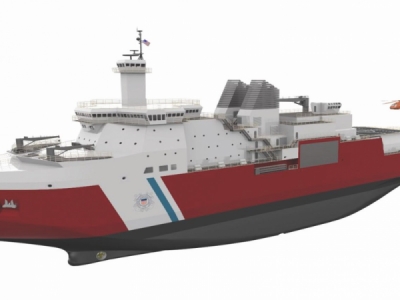
Posted on May 10, 2019
NATIONAL HARBOR, Md. – The Coast Guard’s next icebreaker is based on a German research vessel, features a unique Finnish propulsion design and is driven by American diesels, shipbuilder VT Halter Marine told USNI News on Tuesday.
Ron Baczkowski, the shipyard’s chief executive, outlined the Polar Security Cutter design the company is set to build in its Gulf Coast yard starting in 2021. The lead ship is planned to deliver to the Coast Guard in 2024.
Naval Sea Systems Command and the Coast Guard awarded the yard a $745-million contract last month to build the first-in-class cutter that will be the first of three planned heavy icebreakers for the service.
“We went through a two-year-long study that the U.S. government put out, the Coast Guard actually sponsored it,” Baczkowski said.
“All the teams went out and looked at what is the best way to meet the Coast Guard’s requirement.”
VT Halter Marine selected a hull based on the under-construction German Federal Ministry of Education and Research vessel Polar Stern II. New Orleans design firm Technology Associates, Inc will modify the design for Coast Guard requirements.
“We picked the most modern icebreaker that was on the market, soon to be production-level design that roughly met the Coast Guard’s requirements, and we took it and modified it,” Baczkowski said.
“It has a contoured shape. The shape of the hull does the icebreaking. Instead of being a mass breaking ice, this actually slices the ice. The shape of the hull pushed the broken ice aside, so it doesn’t interfere with your propulsion systems, with your instrumentation that’s on the other side of the ship.”
The design of the cutter is optimized for seakeeping to support the long voyage from its homeport in Washington state to as far away as the Antarctic, he said.
“It’s an optimum design between icebreaking and seakeeping.”
“With the propulsors, with one fixed and two steerable, we were able to optimize the seakeeping capability so when you’re going on long transits from Washington to Antarctica the crew is not beat to a pulp or heavily fatigued because of the stability characteristics in open water.”
For propulsion, the cutter will be driven by a diesel-electric arrangement that will pair three unspecified Caterpillar prime movers paired with electrical motors. The propulsors are based on a Finnish design from ABB and used on several commercial icebreakers.
The ship will displace about 33,000-tons fully loaded and will have accommodations for 186.
“That’s not all crew. There are spaces for scientists to be onboard and special crews for whatever mission package is on there,” he said.
In addition to the icebreaker’s role in resupplying the U.S. mission to Antarctica, the Coast Guard also supports the National Science Foundation with Arctic research missions, primarily with its medium icebreaker USCGC Healy (WAGB-20). On Wednesday, Coast Guard commandant Adm. Karl Schultz said the primary mission of the first icebreaker will be the Antarctic supply mission.
The ship’s combat system will be derived from the Aegis Combat System, and the Coast Guard is still mulling over the weapons loadout, Schultz told reporters on Wednesday.
Now that the contract has been awarded, VT Halter will enter into a detailed design period before beginning fabrication in 2021.
Source: news.usni.org





